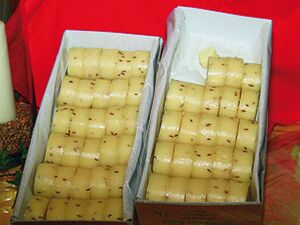Nieheimer cheese

Description
‘Nieheimer Käse’ is a low-fat, high-protein, g.g.A. sour milk cheese.
- Exterior: The exterior is smooth and wrinkle-free, with a yellowish to grey-green colour. The cheese can be covered with hop leaves (in which case there is usually a corresponding reference in connection with the description).
- Interior: The cut surface is smooth, close-textured, uniformly coloured and may be interspersed with caraway. Small pieces of quark which are not fully ripe do not give the desired appearance.
- Odour and taste: The taste is pure, sharp, spicy, with a touch of caraway, depending on the seasoning.
- Shape, size and weight: The cheese is typically produced in cylindrical form with a diameter of 4,0 to 4,5 cm, a height of 2,0 to 2,5 cm and a weight of 32 to 37 g. Variations are possible.
- Composition: The ingredients used to make ‘Nieheimer Käse’ are skimmed milk quark and table salt. The cheese is sold with consistencies which vary from firm enough to cut to grateable. As the cheese matures, the water content decreases and the contents vary accordingly.
Ripening is based solely on the sour quark’s bacterial and yeast culture; no extra ripening cultures are added. This distinguishes ‘Nieheimer Käse’ from other sour milk cheeses . Geographical area
The production area for ‘Nieheimer Käse’ is the municipality of Nieheim. The milk to be used and the dry quark do not have to originate in the geographical area.
Method of production
The cheese is produced from (homemade or bought) dry quark which meets the following quality parameters: dry matter content of at least 33 %, pH value of between 3,9 and 4,3, and fresh-mass fat content of less than 1 %. The dry quark comes 100 % from cows' milk. It is first finely ground in a mincer and put in cases. This quark mass is then placed in a ripening room. The length of the ripening process depends on the temperature and air humidity and can be taken from 3 to 5 days. The quark is fully ripe once the mass has turned a yellowish colour. The right moment for further processing is determined by means of visual and sensory examination undertaken by the individuals responsible. Cooking salt (2,5-3,5 %) and possibly caraway seed (0,01-0,03 %) are then added to the mass, which is mixed until distribution is even. The cheese mass is then shaped into rolls 4,0 to 4,5 cm in diameter, and subsequently cut with a cutting harp into pieces 2,0 to 2,5 cm wide. The small individual cylindrical cheeses are then placed individually on cheese shelves and must be allowed to cool. The cheese is subsequently packed in such a way as to be pervious to air; only in that way can it breathe and dry out slowly. The packaging may additionally consist of a protective layer of hops. In that case a reference is usually made to this variation in packaging and presentation. Variations in presentation are common.
Link to the geographical are
Milk curdles if left to stand in the sun or near a fire. Even before the birth of Christ, interaction had occurred between heat and lactic acid bacteria to produce Germany’s first sour milk cheeses. These are some of the few ‘original German’ cheese inventions. Many German regions have a long-standing tradition of producing a wide variety of sour milk cheeses. ‘Nieheimer Käse’ became a local speciality in the Nieheim area as far back as the early 19th century. In terms of production and ripening, it differs from other varieties of sour milk cheese.
‘Nieheimer Käse’ is a traditional regional speciality which is well known outside the region and highly regarded. The production of ‘Nieheimer Käse’ is based on a centuries-old, farmers’ method of cheese making in Nieheim and the surrounding area. Recipes and experience of cheese making as a local craft were handed down by families. Of key importance is the special production method: the dry quark is first ground and then ripens in vats before being shaped. Nieheim still has a lively cheese tradition, reflected in its regular cheese markets, which started in the 1920s and 1930s and continue to this day.
The Westphalia-Lippe Agricultural Newspaper described cheese from Nieheim as early as 1857, praising its high quality (see Landwirtschaftliche Zeitung für Westfalen-Lippe, XIV 1857, columns 179- 181: Cheese production on ‘Externbrock’ farm in Nieheim, Westphalia).
Further references to ‘Nieheimer Käse’ can be found in Handbuch der Käsereitechnik (H. von Klenze, publisher M. Heinsius 1884, page 586 et seq.), which states that ‘Nieheimer Käse’ originates from the area around Nieheim in Westphalia. Die Warte (No 5/1934, Georg Hilka ‘Aus der heimischen Wirtschaft: Die Zubereitung des weit bekannten Nieheimer Käse’) refers to the fact that ‘Nieheimer Käse’ is a local product from Nieheim and that it goes back centuries. The Molkerei- und Käsereizeitung (Hildesheim, 5/1965, page 173) states that the production of ‘Nieheimer Käse’ is especially concentrated in and around Nieheim.
Reference: The European Commission
Find recipes that contain 'Nieheimer cheese'
#cheese #quark #cheeses #nieheimercheese #caraway #cheesemaking #dairyproducts #cowsmilk #cowsmilkcheeses #hop #fat